A solid update Mr. Capiatlist! The Imperials are sure ready to take on the world at this stage, if they had reason to. Although Poland would be a though nut to crack no matter what.
Flower of the Lilly
- Thread starter Mr. Capiatlist
- Start date
-
We have updated our Community Code of Conduct. Please read through the new rules for the forum that are an integral part of Paradox Interactive’s User Agreement.
You are using an out of date browser. It may not display this or other websites correctly.
You should upgrade or use an alternative browser.
You should upgrade or use an alternative browser.
Hey guys! Just checking in to say that though I am working on an update as we speak, it migh be a while because I am moving back to Purdue soon, I'll see if I cannot get one in before I move back... if not, it will be soon after I move back.
Flower of the Lilly
A Comprehensive look at the Creation of Modern France
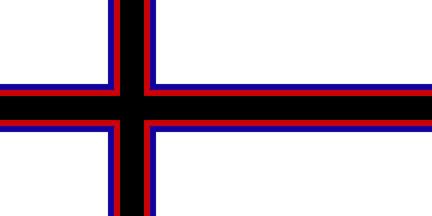
The Union Flag, flown over the Empire
Chapter Thirteen
The Emperor of Emperors
Emperor François IV d’Albret-Bourgogne Jagello-Tudor ve Kalkenbourg began his own dynasty. He dropped the Jagello as the reigning name for a few reasons. First was the growing nationalism within the Empire called for a dynasty that was not foreign in origin. Second were the growing tensions between East and West. Third was the call within the Imperial family for their own identity. The name ve Kalkenbourg came from the Imperial language and meant “of Kalkenburg” the family castle in Köln, named for its white exterior. In German it is “von Kalkenburg” and in French it is “de Kalkenbourg.” Emperor François IV was born Francis George Stephen Constantine von Bamberg-Habsburg duc d’Albret-Navarre-Vasconnes Jagello-Tudor d’Albret-Bourgogne-Montfort ve Kalkenbourg. He quickly rose to prominence as he was the sole heir to another throne, England. This gave François IV his most famous title, The Emperor of Emperors.
King Edward V Tudor was the last reigning English monarch. Despite being a colonial power, England was routinely in debt to its neighbors, having financed long colonial wars against other European powers in North America. After many centuries of war, England and France grew closer. The first issue was Ireland, divided between French Free Ireland and English Ireland. Diplomacy fixed the boundaries and ensured peace of the island. France also helped with England’s mounting debts, but in doing so made England more dependent on France. King Edward eventually saw that it was not just England that owed France, but he personally was in debt to the Empire. In a bargain, he allowed Emperor François III to marry his eldest daughter, Mary of Wales. At the time, François III was the dauphin of France under Emperor Henri IV. King Edward V hoped that he’d have a son before it became an issue, despite having three sons, not one reached adulthood.
The eldest son of François III and Mary died soon after birth, originally named Georg. Next was Francis, who became Dauphin on his sixth birthday. Late in his life, Edward took an interest in his grandson, and heir. He was allowed to see the boy several times a year, and young Francis would often spend months in the Lancaster and Welsh country sides. King Edward V Tudor died in 1670, four years before Emperor François III. Even so, Francis did not accept the Kingdom of England until after he had ascended as Emperor of France in 1674.
Upon taking the thrones, Emperor François IV became the most powerful man in Europe. His high stature fueled a massive ego unlike any Emperor before him. He took efforts in creating symbols that were unique to him and his new dynasty. This included the new Flag of the Empire and a new heraldry drawn to be simplistic and easy to recognize. The new flag, based off of the Nordic Cross of the old flag. The Rïksflagge, or Empire’s Flag in Imperial, quickly became one of the most important and enduring symbols of the Empire. The new coat of arms was a white shield bordered in black with a black lion in the middle.
Emperor François IV’s wife was Margareta von Hesse-Nassau, the fourteen year old Queen of Naples. The two were wed in 1676, after three years of courtship. The wedding merged the Kingdom of Naples, long time ally and vassal of the Empire, to the Empire that cut it off from the rest of Europe. Together, the couple would produce seven sons, the first generation of ve Kalkenbourg heirs. The relationship was known as a very close one. The two had been childhood friends, brought together as their fathers worked together throughout the reign of Emperor François III. Together, the two would operate as a unit, confiding to eat other their worries. Emperor François IV would almost always have his wife with him during state meetings or diplomatic missions.
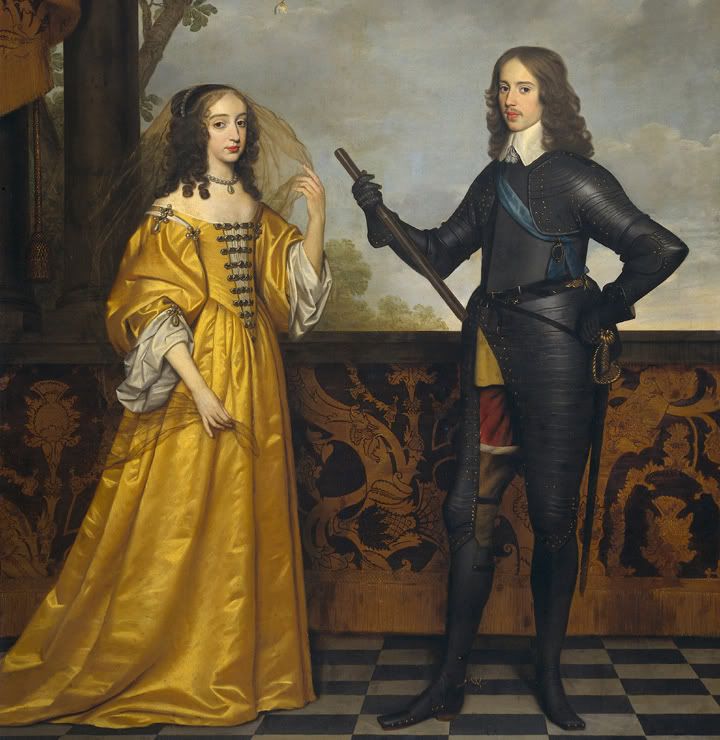
Emperor François IV and Empress Margareta
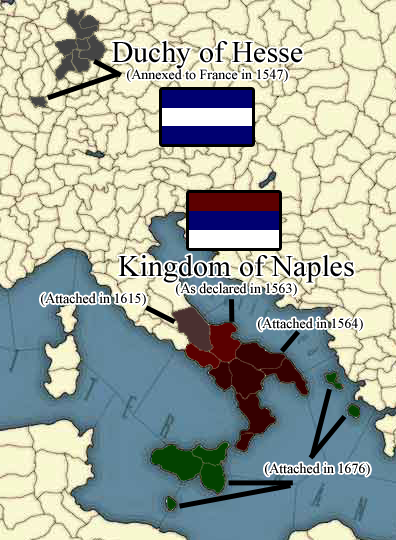
The Evolution of the Kingdom of Naples, from the Duchy of Hesse to the incorperation into the Empire.
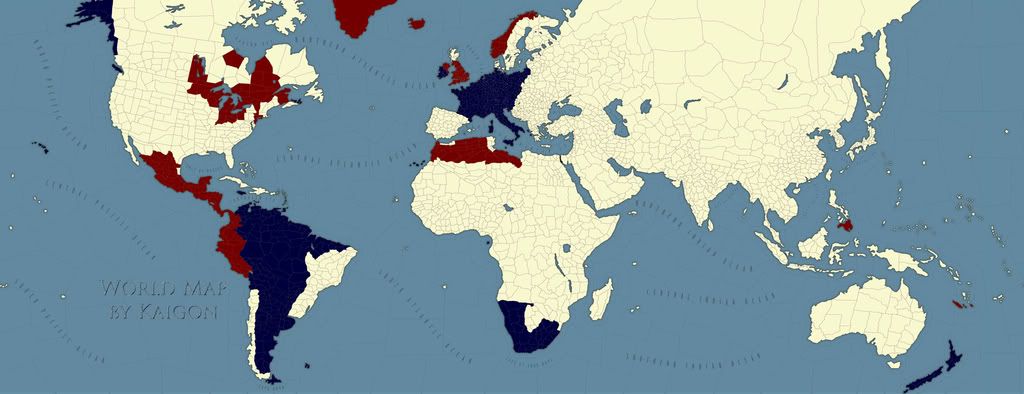
The Union of Empires: The Holy Roman Empire in Blue, the English Empire in Red
Second Bremenite War
End of the Bremenite Movement
Venice sagged under the economic strain of being embargoed by the Empire. People suffered from plague as well as homelessness. The nation consisted only of the city itself, the last remaining portion of the defiant Merchant Republic. Similarly, the Archbishopry of Bremen suffered a similar fate. Both nations were forced to find outside supply, nations willing to dodge the Empire’s blockade and feed their people. Bremen used Helgoland as a trading point with Sweden, Russia and Finland. Venice was forced to buy things from the Empire, a humiliating fact as well as an expensive one. Meanwhile the Bremenite movement still festered within Venice, Bremen and throughout Germany. Outside of those two cities, though, the Bremenite Religion was a small minority. Even so, the community was very united and hugely nationalistic. The idea of a “Bremenite Empire” was a very popular belief within the Bremenite community. The idea of a pan-Bremenite nation was, however, very unlikely, as their minority status prohibited an effective take-over. In other parts of the “Empire,” such as Switzerand and Swabia, Bremenites didn’t even exist. In 1677 Venice underwent a violent coup, and the Merchant Republic gave way to the Bremenite Empire. United with Bremen, the Archbishop there was declared Emperor of the small, divided state. Emperor François IV acted quickly, declaring war on the small pseudo-Empire. The city of Venice was quickly seized and annexed. Meanwhile, the city of Wesser, the capital of the Archbishopry, attempted to hold back 30,000 Imperial troops. Within a week, the city surrendered and the Archbishopry lost most of its territory as well as sovereignty. Forcibly made an Gallican state, the Archbishop was now a vassal of the Emperor.
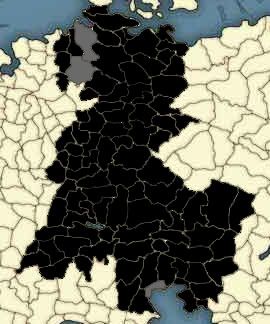
The Theoretical Bremenite Empire
Centralization
Imperial Reforms and the Years of Darkness
Even as late as the 1680’s the Empire still contained thousands of lesser nobles each vying for power, wealth and positions within the Empire, usually trying to get closer to the Emperor and his sons as to marry into the Imperial Family. Two whole branches of the Imperial Government, one based in Luxembourg and the other in München were based in these petty matters. The first was the Imperial Heraldry Institution, based in München. Its job was to keep track of the thousands of nobles, from the Emperor to the petty barons and sires in local governments. It was known for its massive libraries, each containing thousands of tomes tracking the family trees as they criss-crossed, evolved, merged and ended. It also tracked their coat of arms, titles, claims and other political and financial matters. The other was the Imperial Dauphin Society, based in Luxembourg. The Society’s job was creating a list of heirs to the Imperial Throne in their order of succession. The list usually goes to the 500th heir, though during long reigns it can exceed 1000. Emperor François IV was unhappy with the existence of so many nobles holding positions and not doing anything.
The solution to this massive waste of income became simple, eliminate the positions, remove the titles and centralize the authorities to Imperial workers. When word got out, many nobles began rioting, demanding more rights, the return of decentralized feudalism, and the granting of fiefs. They began to ban together into impromptu military units, and began to threaten civil war, coups and assassinations. Fortunately for Emperor François IV, the commoners and middle class sided with him. They saw the noble class as a threat to them. The middle class wanted the jobs taken up by the nobles, and the commoners were tired of the corrupt rule that the nobles enforced. The tension broke into a two-year period from 1680 to 1682 known as the Years of Darkness. A pseudo-civil war marked by revolts, proclamations and the arrest of thousands of nobles. Hangings became wildly accepted as the best method of execution for traitors. Emperor François IV became known throughout Europe as a blood-thirsty killer. Art from the time frame represent him as a vampire, werewolf, demon, or even Satan himself. When the two years were over, over 10,000 nobles had been arrested and over 3,000 were executed for treason. Another 5,000 willingly gave up their titles and positions. Some were spared due to honesty, hard work, higher titles or other connections.
Hawai’ian Blues
Continued wars in New Corsica and New Zealand
During the Years of Darkness in Europe, a new issue was starting to show itself. In New Corsica, a local chief made himself Emperor of the Isles and styled himself in the image and rule of Emperor François IV. It is believed that the Hawai’ians had no idea of just how large the Empire truly was, or how many people it could wield. Emperor Kekoa I began waging a guerilla war against the Imperial colonists and their tiny militias.
Similarly, native New Zealanders waged war against the South Island. South Island had quickly fallen to the Empire due to its sparse native population. Meanwhile, only the southern tip of North Island remained in stable Imperial control. In the North, Maori chieftains remained in total control, attacking Imperial farms and settlements. For many years, colonists, especially colonists in remote locations, had to defend themselves. But in 1685 Emperor François IV declared that both New Corsica and New Zealand were being put under the control of Bolivia, creating the Commonwealth of the Pacific. It also called for the creation of a 10,000 man army and a 15 ship fleet to first head to New Zealand and then later to New Corsica. This army would serve to pacify any unruly natives. Their methods would become infamous, and would spark controversy deep into later centuries.
In 1691, the Pacific Army arrived on North Island. The soldiers spread out, enforcing Imperial rule and the Imperial language and religion. Resistance was met with utter destruction. By 1692 North Island was secured for total Imperial settlement. Within a few months the Pacific Army was headed to New Corsica. Upon landing there, the army started with Isle de François and worked from east to west clearing islands or forcing peaces and truces. Finally, in 1693 Kekoa came to the commander of the Pacific Army and awarded him the title of Emperor, General Karl von Habsburg accepted the title on behalf of Emperor François IV. Even so, François IV only used the title Emperor of Hawai’i jokingly. In 1694, the former Emperor Kekoa left New Corsica on his own free will and went to Europe. He was astounded at the utter size and population of the Empire. His journey brought him to Brazil, Bordeaux, Arles, Paris, Amsterdam, Köln, Luxembourg, Rome, Venice, and Berlin. He wrote back to his former subjects telling them that they never had a chance, that the Empire was “larger than we could have ever imagined. Their cities are bigger than our beloved islands.”
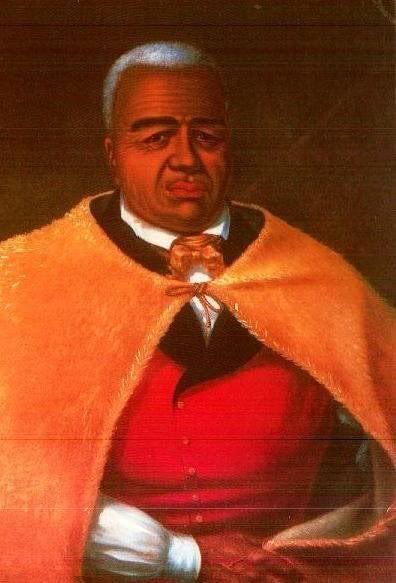
Emperor Kekoa I, Emperor of Hawai'i

New Zealand - Dark Blue represents permanent Imperial control; Light Blue is sporatic Imperial control; Purple is permanent Native control (before the arrival of the Army of the Pacific)
Defender of the Faith
Castilian-Imperial Relationships
In the early days of the Gallican faith France and Castile maintained good relationships. However, the two began having issues. Castile promoted the violent conversion of Catholics and complete intolerance of Protestants. France, and later the Empire, promoted healthy understanding between all Christians. This led Castile to declare itself Defender of the Gallican Faith, a title never protested by the Emperors of the Empire. But in the late 1600’s Castile was in a total state of anarchy. Its army continued to try to keep the peace within the nation and in the colonies. Come 1690, after 30 years of constant chaos, Castile was looking for income. The King of Spain went to Emperor François IV and for a sum of gold, sold him the Defender title. Emperor François IV gladly used the title, flaunting it on his signatures and imperial decrees.
Continuing Unification
Wars in Germany
Emperor François IV pushed unification to a new extreme. During his reign he would annex three more small nations within the Empire (on top of Venice and Naples). Two were done through diplomacy and one through war. The Duchy of Saxony and the Republic of Genoa were annexed under heavy pressure of the Imperial Government in 1687 and 1694 respectively. The Rhine Palatine had been under the yoke of Imperial control for a few centuries now, when its Grand Duke finally decided to end the dominance of what he saw as a French Empire.
In 1685, a Rheinish assassin was caught and hanged in Köln. His target was Emperor François IV. However, the assassin had misjudged François’ return from the summer palace in Arles, and had struck a day in advance. Upon his return and enlightenment to the situation, François marched the Hessen army into the small Duchy. The Grand Duke was hanged along with his advisors and the Duchy annexed into the Empire.
The tenth anniversary of the brief war was celebrated with the opening of the Imperial War College in Köln. The college would produce some of the most brilliant military minds of the modern world. It would also give an education to all future Emperors as well as monarchs in nations as far away as China and India. The college would also serve as a model for later colleges around the Empire.
The Great Blow-up
End of the Great Experiment
In 1693 another civil war was waging. This time it was in Finland. In 1692 a Protestant named Mikael Sakari declared himself the Protector of the Lutherans. He then gathered support with the pious Lutheran population of the southern coast and with Swedish backing began a civil war. Initially the Finnish Republic seemed as if it would win. But with constant funding and eventually military support from Sweden, Sakari was able to defeat the Republican forces and put an end to the “Great Experiment.” On September 13th, 1694 Mikael Sakari became King of Finland, and was later recognized by Sweden and Poland. Within a year all European nations, with the exception of the Papal State, had recognized the new monarchy. Even so, many monarchs worried that the rise of a simple Lieutenant to the position of King would spark a flood of rash revolts as their military officers rise in rebellion, each trying to usurp the throne. Though this trend never took place, in some countries it did lead to the mass arrest of thousands of officers.
Europe as a Whole
Dawn of the new century
Emperor François IV died in 1695 after having reigned for 21 years. He was succeeded by his eldest son, Emperor Nicolas. The coming century Europe and the entire world would undergo radical changes and the age of mechanization, science and industrialism approached.
Nations of Europe
From wealthiest to poorest
Nation----------------------Dynasty
The Holy Roman Empire------ve Kalkenbourg
The Empire of Poland--------Sobieski
The Empire of Moscow-------von Lüneburg-Holstein
The Kingdom of Portugal-----Braganza
The Kingdom of Aragon------de Foix-Bourbon
The Kingdom of Scotland----Stuart
The Kingdom of Denmark----von Lübeck-Mecklenburg
The Kingdom of Sweden-----von Pfalz-Wittelsbach
The Kingdom of Finland------Sakari
The Empire of Morea--------Palaiologos
The Papal State------------>Appointed<
The Kingdom of Castile------Trastámara-Albret
The Caliph of Grenada-------Nasr
The Knights of Rhodos------->Elected<
The Duchy of Naxos--------de Bourbon-Orleans-Lorraine
The Empire of Cyprus-------von Hesse-Bamberg
A Comprehensive look at the Creation of Modern France

The Union Flag, flown over the Empire
Chapter Thirteen
The Emperor of Emperors
Emperor François IV d’Albret-Bourgogne Jagello-Tudor ve Kalkenbourg began his own dynasty. He dropped the Jagello as the reigning name for a few reasons. First was the growing nationalism within the Empire called for a dynasty that was not foreign in origin. Second were the growing tensions between East and West. Third was the call within the Imperial family for their own identity. The name ve Kalkenbourg came from the Imperial language and meant “of Kalkenburg” the family castle in Köln, named for its white exterior. In German it is “von Kalkenburg” and in French it is “de Kalkenbourg.” Emperor François IV was born Francis George Stephen Constantine von Bamberg-Habsburg duc d’Albret-Navarre-Vasconnes Jagello-Tudor d’Albret-Bourgogne-Montfort ve Kalkenbourg. He quickly rose to prominence as he was the sole heir to another throne, England. This gave François IV his most famous title, The Emperor of Emperors.
King Edward V Tudor was the last reigning English monarch. Despite being a colonial power, England was routinely in debt to its neighbors, having financed long colonial wars against other European powers in North America. After many centuries of war, England and France grew closer. The first issue was Ireland, divided between French Free Ireland and English Ireland. Diplomacy fixed the boundaries and ensured peace of the island. France also helped with England’s mounting debts, but in doing so made England more dependent on France. King Edward eventually saw that it was not just England that owed France, but he personally was in debt to the Empire. In a bargain, he allowed Emperor François III to marry his eldest daughter, Mary of Wales. At the time, François III was the dauphin of France under Emperor Henri IV. King Edward V hoped that he’d have a son before it became an issue, despite having three sons, not one reached adulthood.
The eldest son of François III and Mary died soon after birth, originally named Georg. Next was Francis, who became Dauphin on his sixth birthday. Late in his life, Edward took an interest in his grandson, and heir. He was allowed to see the boy several times a year, and young Francis would often spend months in the Lancaster and Welsh country sides. King Edward V Tudor died in 1670, four years before Emperor François III. Even so, Francis did not accept the Kingdom of England until after he had ascended as Emperor of France in 1674.
Upon taking the thrones, Emperor François IV became the most powerful man in Europe. His high stature fueled a massive ego unlike any Emperor before him. He took efforts in creating symbols that were unique to him and his new dynasty. This included the new Flag of the Empire and a new heraldry drawn to be simplistic and easy to recognize. The new flag, based off of the Nordic Cross of the old flag. The Rïksflagge, or Empire’s Flag in Imperial, quickly became one of the most important and enduring symbols of the Empire. The new coat of arms was a white shield bordered in black with a black lion in the middle.
Emperor François IV’s wife was Margareta von Hesse-Nassau, the fourteen year old Queen of Naples. The two were wed in 1676, after three years of courtship. The wedding merged the Kingdom of Naples, long time ally and vassal of the Empire, to the Empire that cut it off from the rest of Europe. Together, the couple would produce seven sons, the first generation of ve Kalkenbourg heirs. The relationship was known as a very close one. The two had been childhood friends, brought together as their fathers worked together throughout the reign of Emperor François III. Together, the two would operate as a unit, confiding to eat other their worries. Emperor François IV would almost always have his wife with him during state meetings or diplomatic missions.

Emperor François IV and Empress Margareta

The Evolution of the Kingdom of Naples, from the Duchy of Hesse to the incorperation into the Empire.

The Union of Empires: The Holy Roman Empire in Blue, the English Empire in Red
Second Bremenite War
End of the Bremenite Movement
Venice sagged under the economic strain of being embargoed by the Empire. People suffered from plague as well as homelessness. The nation consisted only of the city itself, the last remaining portion of the defiant Merchant Republic. Similarly, the Archbishopry of Bremen suffered a similar fate. Both nations were forced to find outside supply, nations willing to dodge the Empire’s blockade and feed their people. Bremen used Helgoland as a trading point with Sweden, Russia and Finland. Venice was forced to buy things from the Empire, a humiliating fact as well as an expensive one. Meanwhile the Bremenite movement still festered within Venice, Bremen and throughout Germany. Outside of those two cities, though, the Bremenite Religion was a small minority. Even so, the community was very united and hugely nationalistic. The idea of a “Bremenite Empire” was a very popular belief within the Bremenite community. The idea of a pan-Bremenite nation was, however, very unlikely, as their minority status prohibited an effective take-over. In other parts of the “Empire,” such as Switzerand and Swabia, Bremenites didn’t even exist. In 1677 Venice underwent a violent coup, and the Merchant Republic gave way to the Bremenite Empire. United with Bremen, the Archbishop there was declared Emperor of the small, divided state. Emperor François IV acted quickly, declaring war on the small pseudo-Empire. The city of Venice was quickly seized and annexed. Meanwhile, the city of Wesser, the capital of the Archbishopry, attempted to hold back 30,000 Imperial troops. Within a week, the city surrendered and the Archbishopry lost most of its territory as well as sovereignty. Forcibly made an Gallican state, the Archbishop was now a vassal of the Emperor.

The Theoretical Bremenite Empire
Centralization
Imperial Reforms and the Years of Darkness
Even as late as the 1680’s the Empire still contained thousands of lesser nobles each vying for power, wealth and positions within the Empire, usually trying to get closer to the Emperor and his sons as to marry into the Imperial Family. Two whole branches of the Imperial Government, one based in Luxembourg and the other in München were based in these petty matters. The first was the Imperial Heraldry Institution, based in München. Its job was to keep track of the thousands of nobles, from the Emperor to the petty barons and sires in local governments. It was known for its massive libraries, each containing thousands of tomes tracking the family trees as they criss-crossed, evolved, merged and ended. It also tracked their coat of arms, titles, claims and other political and financial matters. The other was the Imperial Dauphin Society, based in Luxembourg. The Society’s job was creating a list of heirs to the Imperial Throne in their order of succession. The list usually goes to the 500th heir, though during long reigns it can exceed 1000. Emperor François IV was unhappy with the existence of so many nobles holding positions and not doing anything.
The solution to this massive waste of income became simple, eliminate the positions, remove the titles and centralize the authorities to Imperial workers. When word got out, many nobles began rioting, demanding more rights, the return of decentralized feudalism, and the granting of fiefs. They began to ban together into impromptu military units, and began to threaten civil war, coups and assassinations. Fortunately for Emperor François IV, the commoners and middle class sided with him. They saw the noble class as a threat to them. The middle class wanted the jobs taken up by the nobles, and the commoners were tired of the corrupt rule that the nobles enforced. The tension broke into a two-year period from 1680 to 1682 known as the Years of Darkness. A pseudo-civil war marked by revolts, proclamations and the arrest of thousands of nobles. Hangings became wildly accepted as the best method of execution for traitors. Emperor François IV became known throughout Europe as a blood-thirsty killer. Art from the time frame represent him as a vampire, werewolf, demon, or even Satan himself. When the two years were over, over 10,000 nobles had been arrested and over 3,000 were executed for treason. Another 5,000 willingly gave up their titles and positions. Some were spared due to honesty, hard work, higher titles or other connections.
Hawai’ian Blues
Continued wars in New Corsica and New Zealand
During the Years of Darkness in Europe, a new issue was starting to show itself. In New Corsica, a local chief made himself Emperor of the Isles and styled himself in the image and rule of Emperor François IV. It is believed that the Hawai’ians had no idea of just how large the Empire truly was, or how many people it could wield. Emperor Kekoa I began waging a guerilla war against the Imperial colonists and their tiny militias.
Similarly, native New Zealanders waged war against the South Island. South Island had quickly fallen to the Empire due to its sparse native population. Meanwhile, only the southern tip of North Island remained in stable Imperial control. In the North, Maori chieftains remained in total control, attacking Imperial farms and settlements. For many years, colonists, especially colonists in remote locations, had to defend themselves. But in 1685 Emperor François IV declared that both New Corsica and New Zealand were being put under the control of Bolivia, creating the Commonwealth of the Pacific. It also called for the creation of a 10,000 man army and a 15 ship fleet to first head to New Zealand and then later to New Corsica. This army would serve to pacify any unruly natives. Their methods would become infamous, and would spark controversy deep into later centuries.
In 1691, the Pacific Army arrived on North Island. The soldiers spread out, enforcing Imperial rule and the Imperial language and religion. Resistance was met with utter destruction. By 1692 North Island was secured for total Imperial settlement. Within a few months the Pacific Army was headed to New Corsica. Upon landing there, the army started with Isle de François and worked from east to west clearing islands or forcing peaces and truces. Finally, in 1693 Kekoa came to the commander of the Pacific Army and awarded him the title of Emperor, General Karl von Habsburg accepted the title on behalf of Emperor François IV. Even so, François IV only used the title Emperor of Hawai’i jokingly. In 1694, the former Emperor Kekoa left New Corsica on his own free will and went to Europe. He was astounded at the utter size and population of the Empire. His journey brought him to Brazil, Bordeaux, Arles, Paris, Amsterdam, Köln, Luxembourg, Rome, Venice, and Berlin. He wrote back to his former subjects telling them that they never had a chance, that the Empire was “larger than we could have ever imagined. Their cities are bigger than our beloved islands.”

Emperor Kekoa I, Emperor of Hawai'i

New Zealand - Dark Blue represents permanent Imperial control; Light Blue is sporatic Imperial control; Purple is permanent Native control (before the arrival of the Army of the Pacific)
Defender of the Faith
Castilian-Imperial Relationships
In the early days of the Gallican faith France and Castile maintained good relationships. However, the two began having issues. Castile promoted the violent conversion of Catholics and complete intolerance of Protestants. France, and later the Empire, promoted healthy understanding between all Christians. This led Castile to declare itself Defender of the Gallican Faith, a title never protested by the Emperors of the Empire. But in the late 1600’s Castile was in a total state of anarchy. Its army continued to try to keep the peace within the nation and in the colonies. Come 1690, after 30 years of constant chaos, Castile was looking for income. The King of Spain went to Emperor François IV and for a sum of gold, sold him the Defender title. Emperor François IV gladly used the title, flaunting it on his signatures and imperial decrees.
Continuing Unification
Wars in Germany
Emperor François IV pushed unification to a new extreme. During his reign he would annex three more small nations within the Empire (on top of Venice and Naples). Two were done through diplomacy and one through war. The Duchy of Saxony and the Republic of Genoa were annexed under heavy pressure of the Imperial Government in 1687 and 1694 respectively. The Rhine Palatine had been under the yoke of Imperial control for a few centuries now, when its Grand Duke finally decided to end the dominance of what he saw as a French Empire.
In 1685, a Rheinish assassin was caught and hanged in Köln. His target was Emperor François IV. However, the assassin had misjudged François’ return from the summer palace in Arles, and had struck a day in advance. Upon his return and enlightenment to the situation, François marched the Hessen army into the small Duchy. The Grand Duke was hanged along with his advisors and the Duchy annexed into the Empire.
The tenth anniversary of the brief war was celebrated with the opening of the Imperial War College in Köln. The college would produce some of the most brilliant military minds of the modern world. It would also give an education to all future Emperors as well as monarchs in nations as far away as China and India. The college would also serve as a model for later colleges around the Empire.
The Great Blow-up
End of the Great Experiment
In 1693 another civil war was waging. This time it was in Finland. In 1692 a Protestant named Mikael Sakari declared himself the Protector of the Lutherans. He then gathered support with the pious Lutheran population of the southern coast and with Swedish backing began a civil war. Initially the Finnish Republic seemed as if it would win. But with constant funding and eventually military support from Sweden, Sakari was able to defeat the Republican forces and put an end to the “Great Experiment.” On September 13th, 1694 Mikael Sakari became King of Finland, and was later recognized by Sweden and Poland. Within a year all European nations, with the exception of the Papal State, had recognized the new monarchy. Even so, many monarchs worried that the rise of a simple Lieutenant to the position of King would spark a flood of rash revolts as their military officers rise in rebellion, each trying to usurp the throne. Though this trend never took place, in some countries it did lead to the mass arrest of thousands of officers.
Europe as a Whole
Dawn of the new century
Emperor François IV died in 1695 after having reigned for 21 years. He was succeeded by his eldest son, Emperor Nicolas. The coming century Europe and the entire world would undergo radical changes and the age of mechanization, science and industrialism approached.
Nations of Europe
From wealthiest to poorest
Nation----------------------Dynasty
The Holy Roman Empire------ve Kalkenbourg
The Empire of Poland--------Sobieski
The Empire of Moscow-------von Lüneburg-Holstein
The Kingdom of Portugal-----Braganza
The Kingdom of Aragon------de Foix-Bourbon
The Kingdom of Scotland----Stuart
The Kingdom of Denmark----von Lübeck-Mecklenburg
The Kingdom of Sweden-----von Pfalz-Wittelsbach
The Kingdom of Finland------Sakari
The Empire of Morea--------Palaiologos
The Papal State------------>Appointed<
The Kingdom of Castile------Trastámara-Albret
The Caliph of Grenada-------Nasr
The Knights of Rhodos------->Elected<
The Duchy of Naxos--------de Bourbon-Orleans-Lorraine
The Empire of Cyprus-------von Hesse-Bamberg
Again another good update about how the french dominate the world. 
Do we see a polish revolution before the beginning of 19th century?
Do we see a polish revolution before the beginning of 19th century?
Wow, again, excellent chapter. I really liked what you did with Hawaii and its emperor. I am glad to see that outside of a few revolts that the empire is stable.
I hope not... with Poland as big as it is... :wacko:Enewald said:Again another good update about how the french dominate the world.
Do we see a polish revolution before the beginning of 19th century?
Wow, again, excellent chapter. I really liked what you did with Hawaii and its emperor. I am glad to see that outside of a few revolts that the empire is stable.
Thanks for all the support.
Mr. Capiatlist: ...Upon taking the thrones, Emperor François IV became the most powerful man in Europe.
wonderful ! ! the merger of France and England ! !
Mr. Capiatlist: ...Emperor François IV died in 1695 after having reigned for 21 years.
excellent ! ! he did a good job ! !
magnificent update ! !
wonderful ! ! the merger of France and England ! !
Mr. Capiatlist: ...Emperor François IV died in 1695 after having reigned for 21 years.
excellent ! ! he did a good job ! !
magnificent update ! !
I think you guys will enjoy Nicolas I, the current King. I finally got to play for a bit between four hours of Aerodynamics and six hours of Calculus and Linear Algebra. His reign isn't completed yet, but he is quit the eccentric.
An Anglo-Imperial union? Good god, there's no way they are not going to dominate the entire world. 
Mr. Capiatlist: I think you guys will enjoy Nicolas I, the current King. .. His reign isn't completed yet, but he is quit the eccentric.
do you have an ETA on that update ? ?
do you have an ETA on that update ? ?
Calculus is hard... :wacko: Hopefully a break will come up soon... I really want to play but I have between 20 and 30 hours of homework a week... plus a girlfriend, friends and eating... This AAR is by no means dead... but it is definitely not high on my priorities list right now. Hopefully, I'll see if I cannot squeek an update up in the coming weeks.GhostWriter said:Mr. Capiatlist: I think you guys will enjoy Nicolas I, the current King. .. His reign isn't completed yet, but he is quit the eccentric.
do you have an ETA on that update ? ?
Flower of the Lilly
A Comprehensive look at the Creation of Modern France

The Union Flag, flown over the Empire
Chapter Fourteen
The Conqueror
Emperor Nicolas I ve Kalkenbourg was the first Emperor to drop the long moniker that the previous Emperors all had. He was also the first Emperor not to have d’Albret in his name. Even so, he is also notorious for having one of the longest names ever, thanks in part to his extravagant parents. Nicolas I was born Klaus Adolph Gustaf Stephen George Constantine Francis Jean Julius Augustus Peter Paul Charles Robert von Bamberg-Habsburg duc d’Albret-Navarre-Vasconnes-Aqutaine-Brittany Graf von Köln-Frankfurt-Bordeaux-Paris Jagello-Tudor comte de Bourgogne-Foix-Rhein-Malta Stuart-Plantagenet d’Albret-Bourgogne-Montfort ve Kalkenbourg. The newly crowned Emperor quickly adopted the name Nicolas and limited his full name to Nicolas ve Kalkenbourg. Many nobles and commoners adopted the practice set by their monarch and also began adopting the first-name family-name set up.
At home he was a quiet and simple man, who remained mostly buried in his work. His wife, Katharine von Nassau-Augsburg was the daughter of the Prince of Augsburg; a move which angered Sweden, who was looking to finalize an alliance with the Empire. Nicolas and Katharine had only one child, Heinrich (later Henri). Nicolas was also one of the first Emperors not to take direct control over religious affairs, he himself not being a very religious man. He often left that issue to advisors and the Archbishop of Cologne.
One issue that Emperor Nicolas took direct control over was the art of war. A skilled officer in the armed forces during the reign of his father, he understood the importance of morale in leading troops. Within a few months of his ascension as Emperor of the Empire, Emperor Nicolas was dealing with multiple issues close to home. From Tunisia, Berber pirates raided the southern coast of Sicily and Malta. Merchants from around the Europe and Northern Africa complained to the Empire over the issue and the Electors agreed that something must be done.
Imperial Troops loaded up from Sicily and sailed the short distance from Sicily to North Africa. Meanwhile, the Bishopry of Magdeburg protested the ascent of Emperor Nicolas, and decreed that the Electors should force the Empire to disband. The Bishop said that the Empire had become an abomination to the original purpose of the Holy Roman Empire. The claim was a strong one, and one that if the Electors agreed with would bring a quick end to the legitimacy of Imperial rule. Fortunately, the Electors did not have the power (or in all reality the authority) to disagree with the Emperor. By the 18th Century it was wildly recognized that the Holy Roman Empire had died in all but name.
In 1696, Imperial troops landed in Tunis and surrounded Magdeburg. In both cases casualties were low as Imperial troops simply outgunned any opponent. In Tunis Imperial regents took control and set up control over the nation, turning it into the Imperial Colony of Carthage. From there the Imperial Navy could more easily combat Berber Pirates as well as keep track of the growing Egyptian threat to Imperial domination over the Mediterranean. In Magdeburg the Bishop was found and hanged and its territories added to the Emperor’s direct control.
The quick move to use force in settling issues between the Empire and non-European nations would play a key factor in the reign of Emperor Nicolas I. The issue quickly came to point again when an ally, and distant relative, of the Empire fell to a popular uprising in Cyprus. Since the Crusades, Cyprus had stood as a pillar of Christian supremacy in a sea of Islam. Ruled as a Catholic nation, the island had poor relations with both its Islamic neighbors and its Greek ones as well. The Empire of Morea coveted the island as a former territory of the Byzantine Empire, and wanted it returned to Orthodox control. In 1696 as the Empire battled Tunis, Emperor Manuel IV Palaiologos used his leverage and support of Cyprus’ Greek majority to over throw its Catholic ruler, Emperor Charles VI von Hesse-Bamberg. Charles VI was executed before a cheering crowd who quickly made Manuel IV the regent of Cyprus.
In 1697, the death of Charles VI and his family reached Emperor Nicolas I, who declared himself the true heir of Charles VI and pushed for European support over his Greek counter-part. The Empire of Poland agreed, and the two nations put pressure on Morea to release the island and allow a peaceful Imperial occupation. When Morea refused, Imperial ships immediately flooded the Aegean Sea, stopped all Morean trade and sunk their entire fleet of warships. Then, within a few months, Imperial troops had landed on Cyprus and were crushing any resistance to Imperial control. In 1698, Emperor Nicolas I was crowned King of Cyprus and the island was placed under the direct control of the Imperial Navy.
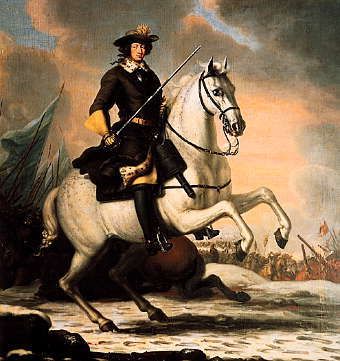
Emperor Nicolas I ve Kalkenbourg, Emperor of the Holy Roman Empire; Battle of Magdeburg
The Enlightened Empire
Emperor Nicolas I and the Decree of Rights
Between 1698 and 1704 the Empire settled into a period of quiet growth. Many had grown to enjoy the reign of their new Emperor, which brought peace and prosperity, though the first was usually through blatant use of force. Then, in 1704 stirrings of trouble began to rise in the Empire. By this time the Enlightenment had not only begun but was slowly creeping into the minds of the middle class. Generally the Imperial government widely supported the middle class, as it provided an excellent ally against the common enemy of the Feudalist nobility. In summer of 1705 the middle class began demanding guaranteed rights that were constant throughout the Empire. Despite attempts to centralize authority, the Empire had not centralized law. This led to “Middle Havens” such as Bordeaux, Paris, Köln, Luxembourg and other large cities and cities in the New World. Middle Havens were cities where the middle class had substantial guaranteed rights. Other cities, especially in rural regions, did not have the same rights granted to non-nobles.
Emperor Nicolas I sympathized with his subjects and in 1705 called together civil leaders in Köln to set right to the problem. Over the course of one year and one month they crafted the “Imperial Bill of Human Right” which made the Empire one of the last Western nations to have a bill of rights. However, as well as drawing from the Magna Carta, the Imperial Bill of Human Rights went beyond its peers and guaranteed further rights, such as the right to peaceful protest, and the most shocking, the freedom of religion. This settled the issue for the middle class, but caused alarm in areas still under the totalitarian rule of local nobles. The Empire enforced that all the rights be recognized and enforced, which made a major push away from the Aristocratic government of old.
The Flow of Spice
Indian-Imperial Relations and the Orissa Trading Company
The Orissa Trading Company had been founded in the early 1600’s to ensure that the Empire’s spice needs were always met. Like many nations, the agreement between the Empire and India was one-sided. A small Indian nation was pressured by threats of force or bribed with money to ensure that a European nation would have a stake in India’s goods. For the Empire the ally was Gondwana, a medium-sized Indian nation. It had maintained its independence from the two main Indian super-powers through its ties with the Empire. The Empires of Bihar and Vijayanagar had risen to prominence through using the support of European nations to bully lesser nations. Eventually, both nations took the example of China and Japan and closed their markets to Europe, making Gondwana (and thus the Empire) the only ties Europe had to the materials it wanted from the Indian Sub-Continent.
In 1707, the Raj of Gondwana decided that he too was going to close his markets to Europe. He began by attempting to arrest all Imperial merchants and sailors in Cuttack. This greatly angered the Imperial government, which sent its ultimatum in the form of 1,000 troops. The Imperial troops stormed the prison, released the Imperial prisoners and enforced their safety in the region. Despite the Raj’s apologies for the misunderstanding, Emperor Nicolas I had the Army of the Pacific moved from New Corsica to New Zealand and placed on stand-by. He also negotiated with Vijayanagar to allow Imperial troops there. In 1708, 10,000 Imperial troops were headed to Cuttack when the Raj used 7,000 Indian troops to overpower the Imperials and have the merchants arrested. A month later, the Imperial ships had arrived and five massive gunships forced their way into the ports. The 10,000 men under the command of Benoît de La Ferrandie quickly cut away at the 7,000 Indian troops and secured the prisoners once again.
With the Orissa province secured and the prisoners safe de La Ferrandie marched into the heart of Gondwana. Indian troops, armed over time by the Europeans, still proved to be no match for the Imperial troops. The Army of the Pacific marched deep into the heart of India. In 1710 de La Ferrandie, acting in the stead of Emperor Nicolas I, declared the Raj of Gondwana deposed and made himself Raj of Orissa, vassal of Emperor Nicolas I of the Holy Roman Empire. Later in 1711, when the Empire officially recognized the government of de La Ferrandie, the Raj of Gondwana was reorganized into the “Most Serine Colony of Orissa” and de La Ferrandie was its first Governor-General. In 1712 the “Riksflagge in Indien” was hoisted above the capital of Cuttack where de La Ferrandie said it would fly for a thousand years.
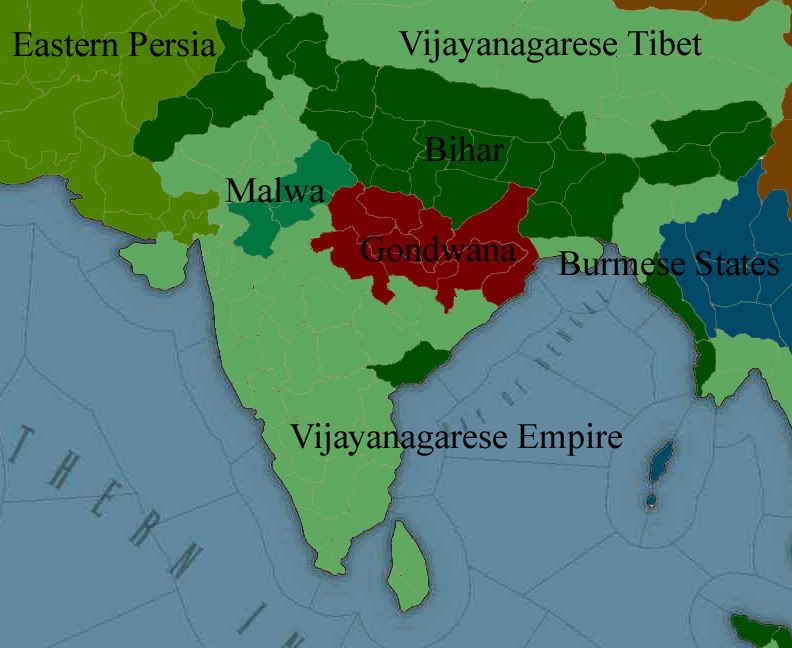
India in 1707
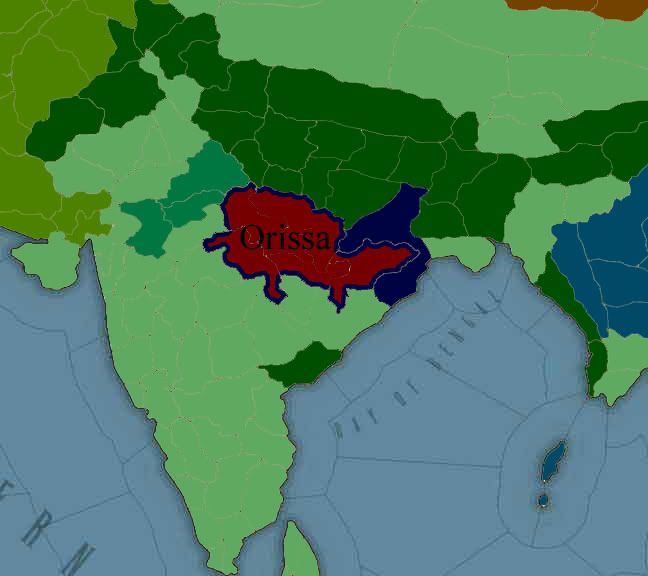
India in 1712 at the rise of Orissa

de La Ferrandie's personal flag in Orissa between 1710 and 1712. It would have been illegal to use a form of the Riksflagge.
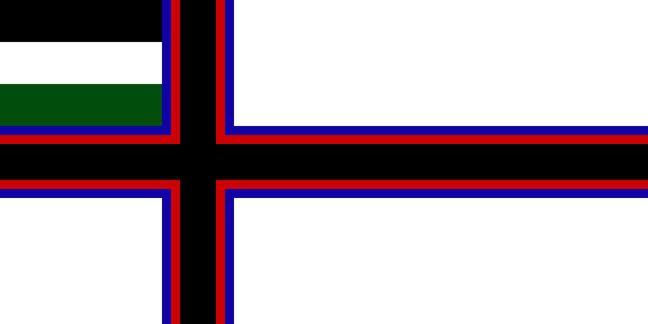
The "Riksflagge in Indien", or the "Empire's Flag in India" the official flag of Orissa.
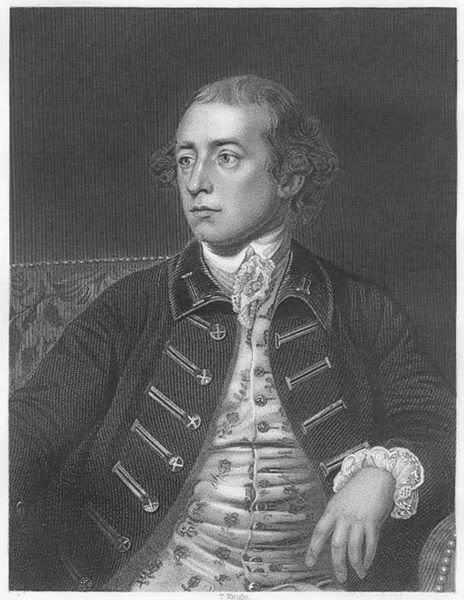
Benoît de La Ferrandie
Poland and the Time of War
Polish Jingoism in the early 18th Century
In the early 18th Century, Poland stood at its own cross roads. Massively powerful and recovering from poverty to join the Holy Roman Empire in splendor and spending, it looked towards its eastern neighbors in contempt and envy. It saw itself as the protector of Western Europe, the iron wall over which no barbarian shall scale. It waged almost constant war with Russia and the Turks and the Egyptians. It stretched from Krakow into the steppe of Siberia. The Kings of Poland styled themselves Emperors, claiming titles such as the Emperors of Byzantium and Russia. The Polish ruling class was an egotistical and elitist organization that dominated the very foundations of life in the Empire. Between 1710 and 1718 Poland went a series of wars pushing its borders to new horizons. In Europe it waged war against Russia, the Turks, the Egyptians and Morea. In Asia it battled the Mongols and the Turkic peoples of the steppe.
In 1710 the Second Polish-Russian war began over a simple issue in the Black Sea. The war quickly got the Holy Roman Empire involved, and lasted barely a year resulting in the deaths of over 300,000 Russians and Poles. With no significant border changes, the Polish hope of ending Russian access to the Black Sea failed.
In 1711, with the failure in Russia still on its mind, Poland invaded the Turkish nation of Osmanistan. Once again the Imperial Armies were also called to fight, and the Holy Roman Empire participated in a few skirmishes before calling a truce with the Osmanis in 1712. In 1713 Poland invaded the Empire of Morea. Emperor Nicolas I, angered with the aggression of Poland, canceled the long with-standing treaty with Poland saying, “I shall never again see my Empire dragged into stupid and petty wars for that drunken Tsar.”
The 1713 War proved disastrous for Poland. Despite relatively little change in the political boundaries, the fact that the poor, tiny remains of the Byzantine Empire could hold off the might of the Polish Empire made many nations second-guess their treaties with Poland. Poland looked very weak in the eyes of Europe.
In an attempt to cover up for its previous blunderings, Poland embarked on an ambitious plan on conquest. The region it sought was the northern Syrian territory of Egypt. In 1714 Egypt was still a powerful player in Mediterranean politics. Second only to the Holy Roman Empire, it was a massive trader and controlled a large portion of the African continent. It was not as technologically progressed as Poland, but still had a massive standing army. In 1714 Poland crossed into Syria, and began a 2-year conflict that gained a modest amount of land. Poland declared it a crusade against Islam, a highly unpopular position in an increasingly tolerant Europe. So despite reaffirming itself as a military power, Poland increasingly divided itself from the rest of Europe.
Fire of Europe
The Union of Stockholm and the Age of Distrust
In 1714 the Kingdom of Finland was annexed to Sweden, ending its 50 year existence. The annexation and collection of a second Kingly title gave the King of Sweden the drive to unite Scandinavia into one Empire once again. It had taken a series of long, costly wars to bring Finland back into the fold, so it was planned that that rest of unity should be in one fell swoop. The invasion of Denmark was swift, taking only a few months to complete. In 1715 the Union of Stockholm was formed, an ironic parody of the Union of Kalmar. The Union encompassed the Kingdoms of “Sweden, Finland, Denmark, Norway and Iceland.” The last two angered Emperor Nicolas, as they were titles of the Holy Roman Empire.
The King of Sweden had inadvertently started the Age of Distrust. Starting with the isolation of Poland, and formalizing with the Union of Stockholm, Europe had been divided into obvious camps of powers. All distrusted the others, and most alliances disappeared. Europe was looking more and more like a massive powder keg, and it was obvious that the Holy Roman Empire held a massive advantage if it weren’t for its reluctance to go to war with another major European power. In 1716, Emperor Nicolas was growing closer to the end of his life. He stepped down in favor of his son Heinrich. Emperor Nicolas I ve Kalkenbourg retired to Luxembourg where he would die in 1720. He offered this advice to the Holy Roman Empire, “Unite; unity in this age is important. And always, always keep your guns loaded and pointed at Poland.”
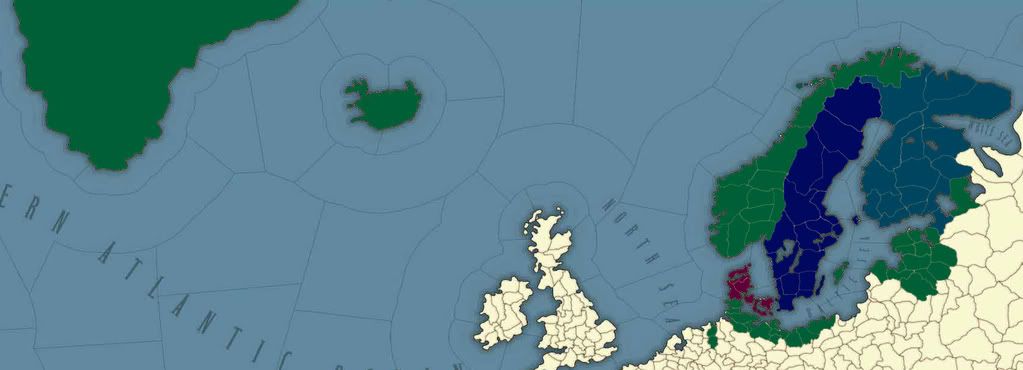
The Union of Stockholm. Sweden in dark blue, Finland in light blue, Denmark in red and claimed territories in green.
A Comprehensive look at the Creation of Modern France

The Union Flag, flown over the Empire
Chapter Fourteen
The Conqueror
Emperor Nicolas I ve Kalkenbourg was the first Emperor to drop the long moniker that the previous Emperors all had. He was also the first Emperor not to have d’Albret in his name. Even so, he is also notorious for having one of the longest names ever, thanks in part to his extravagant parents. Nicolas I was born Klaus Adolph Gustaf Stephen George Constantine Francis Jean Julius Augustus Peter Paul Charles Robert von Bamberg-Habsburg duc d’Albret-Navarre-Vasconnes-Aqutaine-Brittany Graf von Köln-Frankfurt-Bordeaux-Paris Jagello-Tudor comte de Bourgogne-Foix-Rhein-Malta Stuart-Plantagenet d’Albret-Bourgogne-Montfort ve Kalkenbourg. The newly crowned Emperor quickly adopted the name Nicolas and limited his full name to Nicolas ve Kalkenbourg. Many nobles and commoners adopted the practice set by their monarch and also began adopting the first-name family-name set up.
At home he was a quiet and simple man, who remained mostly buried in his work. His wife, Katharine von Nassau-Augsburg was the daughter of the Prince of Augsburg; a move which angered Sweden, who was looking to finalize an alliance with the Empire. Nicolas and Katharine had only one child, Heinrich (later Henri). Nicolas was also one of the first Emperors not to take direct control over religious affairs, he himself not being a very religious man. He often left that issue to advisors and the Archbishop of Cologne.
One issue that Emperor Nicolas took direct control over was the art of war. A skilled officer in the armed forces during the reign of his father, he understood the importance of morale in leading troops. Within a few months of his ascension as Emperor of the Empire, Emperor Nicolas was dealing with multiple issues close to home. From Tunisia, Berber pirates raided the southern coast of Sicily and Malta. Merchants from around the Europe and Northern Africa complained to the Empire over the issue and the Electors agreed that something must be done.
Imperial Troops loaded up from Sicily and sailed the short distance from Sicily to North Africa. Meanwhile, the Bishopry of Magdeburg protested the ascent of Emperor Nicolas, and decreed that the Electors should force the Empire to disband. The Bishop said that the Empire had become an abomination to the original purpose of the Holy Roman Empire. The claim was a strong one, and one that if the Electors agreed with would bring a quick end to the legitimacy of Imperial rule. Fortunately, the Electors did not have the power (or in all reality the authority) to disagree with the Emperor. By the 18th Century it was wildly recognized that the Holy Roman Empire had died in all but name.
In 1696, Imperial troops landed in Tunis and surrounded Magdeburg. In both cases casualties were low as Imperial troops simply outgunned any opponent. In Tunis Imperial regents took control and set up control over the nation, turning it into the Imperial Colony of Carthage. From there the Imperial Navy could more easily combat Berber Pirates as well as keep track of the growing Egyptian threat to Imperial domination over the Mediterranean. In Magdeburg the Bishop was found and hanged and its territories added to the Emperor’s direct control.
The quick move to use force in settling issues between the Empire and non-European nations would play a key factor in the reign of Emperor Nicolas I. The issue quickly came to point again when an ally, and distant relative, of the Empire fell to a popular uprising in Cyprus. Since the Crusades, Cyprus had stood as a pillar of Christian supremacy in a sea of Islam. Ruled as a Catholic nation, the island had poor relations with both its Islamic neighbors and its Greek ones as well. The Empire of Morea coveted the island as a former territory of the Byzantine Empire, and wanted it returned to Orthodox control. In 1696 as the Empire battled Tunis, Emperor Manuel IV Palaiologos used his leverage and support of Cyprus’ Greek majority to over throw its Catholic ruler, Emperor Charles VI von Hesse-Bamberg. Charles VI was executed before a cheering crowd who quickly made Manuel IV the regent of Cyprus.
In 1697, the death of Charles VI and his family reached Emperor Nicolas I, who declared himself the true heir of Charles VI and pushed for European support over his Greek counter-part. The Empire of Poland agreed, and the two nations put pressure on Morea to release the island and allow a peaceful Imperial occupation. When Morea refused, Imperial ships immediately flooded the Aegean Sea, stopped all Morean trade and sunk their entire fleet of warships. Then, within a few months, Imperial troops had landed on Cyprus and were crushing any resistance to Imperial control. In 1698, Emperor Nicolas I was crowned King of Cyprus and the island was placed under the direct control of the Imperial Navy.

Emperor Nicolas I ve Kalkenbourg, Emperor of the Holy Roman Empire; Battle of Magdeburg
The Enlightened Empire
Emperor Nicolas I and the Decree of Rights
Between 1698 and 1704 the Empire settled into a period of quiet growth. Many had grown to enjoy the reign of their new Emperor, which brought peace and prosperity, though the first was usually through blatant use of force. Then, in 1704 stirrings of trouble began to rise in the Empire. By this time the Enlightenment had not only begun but was slowly creeping into the minds of the middle class. Generally the Imperial government widely supported the middle class, as it provided an excellent ally against the common enemy of the Feudalist nobility. In summer of 1705 the middle class began demanding guaranteed rights that were constant throughout the Empire. Despite attempts to centralize authority, the Empire had not centralized law. This led to “Middle Havens” such as Bordeaux, Paris, Köln, Luxembourg and other large cities and cities in the New World. Middle Havens were cities where the middle class had substantial guaranteed rights. Other cities, especially in rural regions, did not have the same rights granted to non-nobles.
Emperor Nicolas I sympathized with his subjects and in 1705 called together civil leaders in Köln to set right to the problem. Over the course of one year and one month they crafted the “Imperial Bill of Human Right” which made the Empire one of the last Western nations to have a bill of rights. However, as well as drawing from the Magna Carta, the Imperial Bill of Human Rights went beyond its peers and guaranteed further rights, such as the right to peaceful protest, and the most shocking, the freedom of religion. This settled the issue for the middle class, but caused alarm in areas still under the totalitarian rule of local nobles. The Empire enforced that all the rights be recognized and enforced, which made a major push away from the Aristocratic government of old.
The Flow of Spice
Indian-Imperial Relations and the Orissa Trading Company
The Orissa Trading Company had been founded in the early 1600’s to ensure that the Empire’s spice needs were always met. Like many nations, the agreement between the Empire and India was one-sided. A small Indian nation was pressured by threats of force or bribed with money to ensure that a European nation would have a stake in India’s goods. For the Empire the ally was Gondwana, a medium-sized Indian nation. It had maintained its independence from the two main Indian super-powers through its ties with the Empire. The Empires of Bihar and Vijayanagar had risen to prominence through using the support of European nations to bully lesser nations. Eventually, both nations took the example of China and Japan and closed their markets to Europe, making Gondwana (and thus the Empire) the only ties Europe had to the materials it wanted from the Indian Sub-Continent.
In 1707, the Raj of Gondwana decided that he too was going to close his markets to Europe. He began by attempting to arrest all Imperial merchants and sailors in Cuttack. This greatly angered the Imperial government, which sent its ultimatum in the form of 1,000 troops. The Imperial troops stormed the prison, released the Imperial prisoners and enforced their safety in the region. Despite the Raj’s apologies for the misunderstanding, Emperor Nicolas I had the Army of the Pacific moved from New Corsica to New Zealand and placed on stand-by. He also negotiated with Vijayanagar to allow Imperial troops there. In 1708, 10,000 Imperial troops were headed to Cuttack when the Raj used 7,000 Indian troops to overpower the Imperials and have the merchants arrested. A month later, the Imperial ships had arrived and five massive gunships forced their way into the ports. The 10,000 men under the command of Benoît de La Ferrandie quickly cut away at the 7,000 Indian troops and secured the prisoners once again.
With the Orissa province secured and the prisoners safe de La Ferrandie marched into the heart of Gondwana. Indian troops, armed over time by the Europeans, still proved to be no match for the Imperial troops. The Army of the Pacific marched deep into the heart of India. In 1710 de La Ferrandie, acting in the stead of Emperor Nicolas I, declared the Raj of Gondwana deposed and made himself Raj of Orissa, vassal of Emperor Nicolas I of the Holy Roman Empire. Later in 1711, when the Empire officially recognized the government of de La Ferrandie, the Raj of Gondwana was reorganized into the “Most Serine Colony of Orissa” and de La Ferrandie was its first Governor-General. In 1712 the “Riksflagge in Indien” was hoisted above the capital of Cuttack where de La Ferrandie said it would fly for a thousand years.

India in 1707

India in 1712 at the rise of Orissa

de La Ferrandie's personal flag in Orissa between 1710 and 1712. It would have been illegal to use a form of the Riksflagge.

The "Riksflagge in Indien", or the "Empire's Flag in India" the official flag of Orissa.

Benoît de La Ferrandie
Poland and the Time of War
Polish Jingoism in the early 18th Century
In the early 18th Century, Poland stood at its own cross roads. Massively powerful and recovering from poverty to join the Holy Roman Empire in splendor and spending, it looked towards its eastern neighbors in contempt and envy. It saw itself as the protector of Western Europe, the iron wall over which no barbarian shall scale. It waged almost constant war with Russia and the Turks and the Egyptians. It stretched from Krakow into the steppe of Siberia. The Kings of Poland styled themselves Emperors, claiming titles such as the Emperors of Byzantium and Russia. The Polish ruling class was an egotistical and elitist organization that dominated the very foundations of life in the Empire. Between 1710 and 1718 Poland went a series of wars pushing its borders to new horizons. In Europe it waged war against Russia, the Turks, the Egyptians and Morea. In Asia it battled the Mongols and the Turkic peoples of the steppe.
In 1710 the Second Polish-Russian war began over a simple issue in the Black Sea. The war quickly got the Holy Roman Empire involved, and lasted barely a year resulting in the deaths of over 300,000 Russians and Poles. With no significant border changes, the Polish hope of ending Russian access to the Black Sea failed.
In 1711, with the failure in Russia still on its mind, Poland invaded the Turkish nation of Osmanistan. Once again the Imperial Armies were also called to fight, and the Holy Roman Empire participated in a few skirmishes before calling a truce with the Osmanis in 1712. In 1713 Poland invaded the Empire of Morea. Emperor Nicolas I, angered with the aggression of Poland, canceled the long with-standing treaty with Poland saying, “I shall never again see my Empire dragged into stupid and petty wars for that drunken Tsar.”
The 1713 War proved disastrous for Poland. Despite relatively little change in the political boundaries, the fact that the poor, tiny remains of the Byzantine Empire could hold off the might of the Polish Empire made many nations second-guess their treaties with Poland. Poland looked very weak in the eyes of Europe.
In an attempt to cover up for its previous blunderings, Poland embarked on an ambitious plan on conquest. The region it sought was the northern Syrian territory of Egypt. In 1714 Egypt was still a powerful player in Mediterranean politics. Second only to the Holy Roman Empire, it was a massive trader and controlled a large portion of the African continent. It was not as technologically progressed as Poland, but still had a massive standing army. In 1714 Poland crossed into Syria, and began a 2-year conflict that gained a modest amount of land. Poland declared it a crusade against Islam, a highly unpopular position in an increasingly tolerant Europe. So despite reaffirming itself as a military power, Poland increasingly divided itself from the rest of Europe.
Fire of Europe
The Union of Stockholm and the Age of Distrust
In 1714 the Kingdom of Finland was annexed to Sweden, ending its 50 year existence. The annexation and collection of a second Kingly title gave the King of Sweden the drive to unite Scandinavia into one Empire once again. It had taken a series of long, costly wars to bring Finland back into the fold, so it was planned that that rest of unity should be in one fell swoop. The invasion of Denmark was swift, taking only a few months to complete. In 1715 the Union of Stockholm was formed, an ironic parody of the Union of Kalmar. The Union encompassed the Kingdoms of “Sweden, Finland, Denmark, Norway and Iceland.” The last two angered Emperor Nicolas, as they were titles of the Holy Roman Empire.
The King of Sweden had inadvertently started the Age of Distrust. Starting with the isolation of Poland, and formalizing with the Union of Stockholm, Europe had been divided into obvious camps of powers. All distrusted the others, and most alliances disappeared. Europe was looking more and more like a massive powder keg, and it was obvious that the Holy Roman Empire held a massive advantage if it weren’t for its reluctance to go to war with another major European power. In 1716, Emperor Nicolas was growing closer to the end of his life. He stepped down in favor of his son Heinrich. Emperor Nicolas I ve Kalkenbourg retired to Luxembourg where he would die in 1720. He offered this advice to the Holy Roman Empire, “Unite; unity in this age is important. And always, always keep your guns loaded and pointed at Poland.”

The Union of Stockholm. Sweden in dark blue, Finland in light blue, Denmark in red and claimed territories in green.
Sound advice, given the circumstances in this timeline. Finally some colonial/Indian action again eh? Or rather, finally some action again overall! It's good having you back Mr. Capiatlist.
India is kinda scary... far away and made up of two rather large nations more technologically advanced than Russia.Qorten said:Sound advice, given the circumstances in this timeline. Finally some colonial/Indian action again eh? Or rather, finally some action again overall! It's good having you back Mr. Capiatlist.
Currently we are in the slide to the end of the game so action might be reduced to the RP sections or one very, very big explosive war. So everyone's continued support will ensure this AAR is finished.
Great chapter!
It seems that India has found itself in the sphere of influence of Imperial France? I wonder if there will be some more...skirmshes
Poland seems weak, attack now, suffer the reputation hits, but at least it will be worth it to crush Poland into Oblivion so that they can't rebound.
It seems that India has found itself in the sphere of influence of Imperial France? I wonder if there will be some more...skirmshes
Poland seems weak, attack now, suffer the reputation hits, but at least it will be worth it to crush Poland into Oblivion so that they can't rebound.
Poland stretches from my western border to china... so I am avoiding the situation, plus tensions are building between me and several other European nations.comagoosie said:Great chapter!
It seems that India has found itself in the sphere of influence of Imperial France? I wonder if there will be some more...skirmshes
Poland seems weak, attack now, suffer the reputation hits, but at least it will be worth it to crush Poland into Oblivion so that they can't rebound.
Next update appears that it will contain two Emperors thanks to a three year reign... ::Sigh::
The next few update has had to be a combination of several kings... unfortunately my Emperors are not living nearly as long anymore... some as short as 3 years. And even ones that last as long(/sarcasm) as 12 or 8 years manage to do very little.
Next update includes 4 Emperors spanning a mere 28 years.
Next update includes 4 Emperors spanning a mere 28 years.

